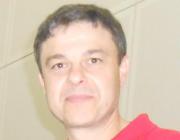Academic Years 2012-2021, compulsory for solid state physics direction, Y3503
EM = electromagnetic 2LS = two-level system, 3LS = three-level system, PLS = poly-level system
Chapter 1. Introduction to the quantum nature of light. Chapter 2. EM radiation - matter (2LS) interaction mechanisms. Chapter 3. Semiclassical approach of the EM radiation – matter (2LS, 3LS, PLS) interaction. EM field: classically. 2LS, 3LS, PLS: quantum mechanically. Chapter 4. Quantum-mechanical approach of the EM radiation – matter (2LS, 3LS, PLS) interaction. EM field quantization. Chapter 5. Lasers. Chapter 6. Density Matrix. Chapter 7. Several additional issues for laser properties and operation. For all Academic Years I have taught the course, evaluation by the students has been done. The results can be found in the relevant National and Kapodistrian University of Athens website. Video-lectures of this course exist for Academic Years 2014, 2019, 2020 on the National and Kapodistrian University of Athens website https://delos.uoa.gr/opendelos/ My e-class https://eclass.uoa.gr/courses/PHYS107/ contains the e-book Quantum Optics and Lasers written by me and all the past exams problems solved as well as other didactic material.
Contents:
CHAPTER 1. Introduction to the quantum nature of light. 1. Black body and related notions. 2. EM radiation energy density in infinitesimal frequency range, black body in thermodynamical equilibrium, ρ(ν,T)dν : Planck’s law and comparison with the classical approaches of Rayleigh-Jeans and Wien. Ultraviolet catastrophe and far infrared problem. 3. Two formulations of the Stefan-Boltzmann law of black body in thermal equilibrium: (1) EM radiation energy density u(T), and (2) radiated power per unit area I. 4. Maxwell equations. Formulation in term of total charge and total current. 5. Boundary conditions at an interface. 6. Existence of EM waves when ρ = 0, J = 0. 7. Fields inside an ideal conductor. 8. Fields at the boundary of an ideal conductor. 9. Fields in cavities. 10. Normal modes of EM waves in a rectangular cavity. 11. Infinitesimal number of normal modes per infinitesimal frequency range, g(ν) = dN/dν. 1st case: periodic boundary conditions. 2nd case: in rectangular cavity. 12. Proof of the classical Rayleigh-Jeans law from the equipartition of energy theorem and g(ν) = dN/dν. Ultraviolet catastrophe. 13. Proof of Planck law. 14. Proof of Wien displacement law. 15. Photoelectric effect.
CHAPTER 2. EM radiation - matter (two-level system) interaction mechanisms. 1. Einstein interaction mechanisms between EM radiation and a two-level system: (Stimulated) absorption. Spontaneous Emission. Stimulated Emission. Einstein coefficients A, B. 2 Derivation of Planck’s formula from the above mechanisms and Boltzmann statistics. Relation between Einstein coefficients A and B. 3. Emissions comparison. Stimulated processes comparison. 4. Discrete spectrum: atoms and molecules, color centers, artificial atoms and molecules (quantum dots).
CHAPTER 3. Semiclassical approach of the EM radiation - matter (2LS, 3LS, PLS) interaction. Electromagnetic field: classically. Two-level, Three-Level, Multi-Level system: quantum mechanically. 1. Semiclassical approach: EM field classically. Two-level system quantum mechanically. 2. Unperturbed system, i.e., without EM field. 3. Perturbed system, i.e., subjected to EM field. Time-dependent perturbation theory. Dipole moment. Dipole approximation. 4. Equations describing the temporal evolution of a two-level system. Rabi frequency. Rotating Wave Approximation (RWA). 5. Solution of the differential equations we obtain after RWA with the simplistic Newton recursive method. 6. Einstein coefficients calculation. 7. Einstein coefficients calculation using the solutions we found in section 3.4. 8. Allowed and forbidden optical transitions within dipole approximation. 9. “Eigenenergies“of perturbed two-level system (i.e. subjected to EM field). 10. Hydrogen atom: atomic orbitals shape. 11. Hydrogen atom: Calculation of the dipole moment matrix elements. Allowed and forbidden optical transitions. Selection rules.
CHAPTER 4. Quantum-mechanical approach of the EM field – matter interaction. EM field quantization. 1. Full Quantum Mechanical Approach versus Semiclassical Approach. 2. Relation between wavevectors, cyclic frequencies and phases of the electric and the magnetic field. 3. Standing EM field ina cavity. 4. EM field Hamiltonian with creation and annihilation operators. 5. Two-level system Hamiltonian with spinors. 6. Boson (e.g. photon) commutation relations and fermion (e.g. electron) anticommutation relations. 7. Ladder operators. 8. EM field – two-level system interaction Hamiltonian. 9. Hamiltonians synopsis. 10. Mean values of various quantities for the Jaynes-Cummings Hamiltonian. 11. Photon absorption. 12. Photon Emission.
CHPTER 5. Lasers. 1. Laser He-Ne. 2. Rate equations for the level populations that contribute to the coherent EM radiation emission and for the radiation density. 3. Longitudinal modes within line width. 4. Level populations and EM radiation density in the steady state. Critical pumping. Population inversion. 5. Numerical solution of the rate equations in the general case. 6. Simulation Lab: numerical solution of the rate equations in the general case. 7. Stationary EM waves in 3D cavity: Longitudinal and transverse modes. 8. Shape of TEM00 and higher order TEMp′q′ in rectangular and cylindrical cavity. 9. Laser species - some applications. 10. Diode Laser or p-n junction laser. 11. Quantum Dot Laser.
CHAPTER 6. Density Matrix 1. Density matrix. 2. Pure state and mixed state. 3. Density matrix and density operator. 4. Density matrix and density operator in a pure state of a two-level system. 5. The temporal evolution of the density matrix: The von Neumann equation. 6. The temporal evolution of the density matrix with relaxation mechanisms.
CHAPTER 7. Several additional issues for laser properties and operation. 1. Isolation of TEM00 and higher order TEMp′q′. 2. Fresnel equations. Brewster angle. 3. Total internal reflection. 4. Polarized beam emission. 5. Poynting vector.

